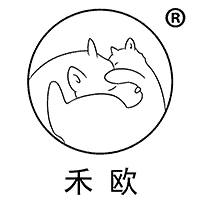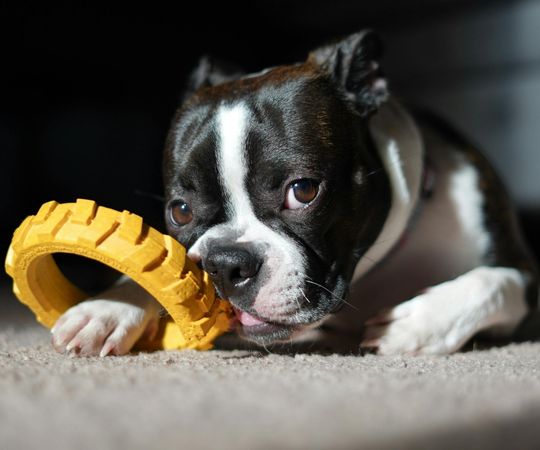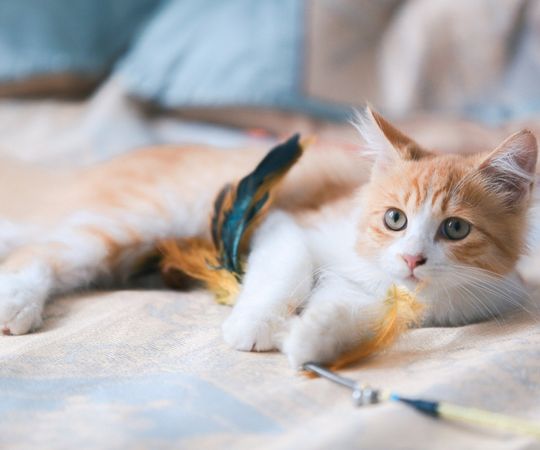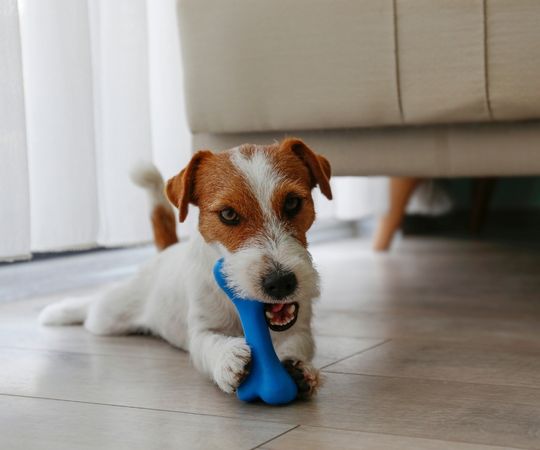Your dog’s toys get super gross. Think about it – those chew toys and plushies spend hours in your dog’s mouth, collecting drool, dirt, and bacteria. Plus, they end up under furniture, in the yard, and who knows where else!
Regular cleaning extends the life of your dog’s favorite toys and protects their health. Let’s get those doggy treasures clean!
The Importance of Cleaning Dog Toys
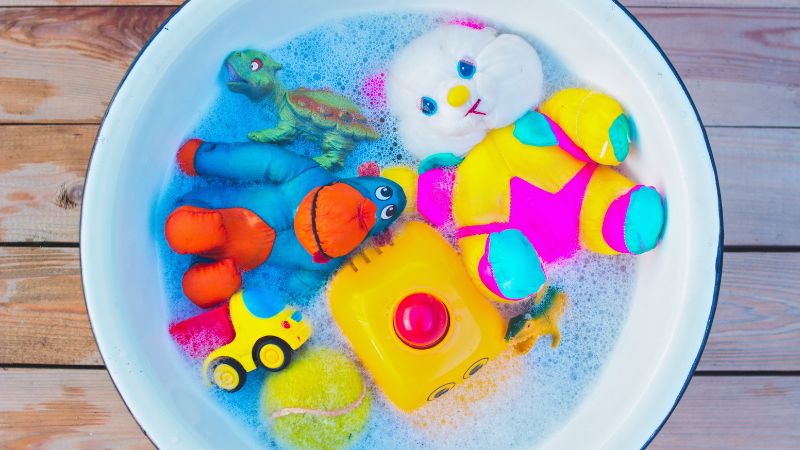
Your dog’s toys collect dirt, saliva, and bacteria over time. Regular cleaning helps protect your pup’s health and extends the life of their favorite playthings.
Bacteria and Germs on Toys
Dog toys are magnets for harmful bacteria. Each time your dog plays with a toy, they transfer bacteria from their mouth onto the surface.
A study found that dog toys can harbor dangerous bacteria like E. coli and Staphylococcus.
Outdoor toys pick up even more germs from dirt, grass, and other surfaces. These toys may contain pesticides, fertilizers, and other chemicals that could harm your pet.
So, regularly giving dog toys a good clean is super important!
Impact on Dog’s Health
Dirty toys can lead to various health problems for your furry friend.
When dogs chew on germ-covered toys, they may develop digestive issues like vomiting and diarrhea.
Dental problems are another concern. Bacteria from dirty toys can contribute to tooth decay, gum disease, and bad breath in your pet.
Dogs with sensitive immune systems or allergies are at even higher risk. They might experience skin irritations or infections from contacting contaminated toys.
Put some toys away for cleaning while keeping others available for play. This practice reduces bacterial buildup and keeps your dog interested in their toys.
How Often Should You Clean Dog Toys?

Dogs love their toys, but these playthings can get pretty gross over time.
Moderate-Use Toys: Most experts recommend washing your dog’s favorite toys at least twice a month to keep them in good condition.
Frequently-Used Toys: For toys that your dog plays with frequently, you should clean them at least once a week. This is especially important for items that get covered in drool, dirt, or food residue.
Some pet owners use a rotation system to stay organized.
Try this approach:
- Group 1 toys: Clean on the first and third weeks of the month
- Group 2 toys: Clean on the second and fourth weeks of the month
This systematic cleaning schedule helps make sure all toys get regular attention without overwhelming you with cleaning chores all at once.
How to Clean Hard Toys?
Fill a sink with warm water and add a small amount of mild dish soap. Avoid strong chemicals that might harm your dog if not rinsed properly.
Use an old toothbrush to scrub hard-to-reach areas where treats, saliva, and dirt collect. Pay special attention to grooves, holes, and crevices.
For extra disinfecting power, try this solution:
- 1 part white vinegar
- 2 parts water
- A few drops of mild dish soap
Rinse thoroughly with clean water to remove all soap residue. Any leftover cleaning solution could upset your dog’s stomach.
How to Clean Rope Toys?
Dog rope toys are a staple for playtime, but they’re prone to collecting dirt, saliva, and bacteria.
The easiest way to freshen them up is in the washing machine.
Toss the toys into a mesh laundry bag (to prevent tangling) and run them on a gentle cycle with cold water and mild detergent. Avoid bleach or fabric softeners, which can weaken the fibers.
If your rope toy has wooden beads, knots, or plastic parts, skip the machine and opt for hand-washing instead.
Fill a basin with warm water and a small amount of pet-safe soap, then scrub the toy gently with a soft brush or cloth. Rinse thoroughly under running water to remove all soap residue.
Once clean, squeeze out excess water and hang the toy in a sunny spot to air-dry. Avoid using a dryer, as heat can damage the fibers or melt any non-fabric components.
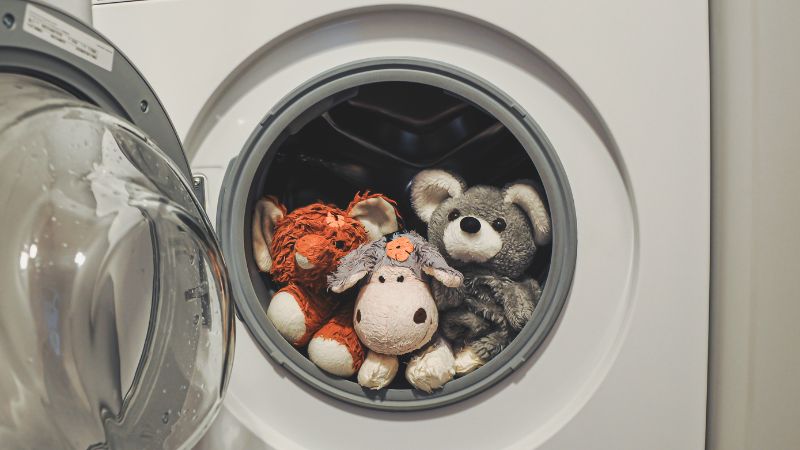
How to Clean Plush Dog Toys?
Plush toys are your dog’s cuddly companions, but they’re also slobber and dirt magnets. Keep them fresh with these simple steps:
Machine Washing Method
- Check the toy for any tears or loose parts
- Place toys in a mesh laundry bag
- Use pet-safe cleaning solution
- Wash on gentle cycle with cold water
- Run an extra rinse cycle to remove all soap residue
You can also add 1/4 cup of white vinegar instead of detergent for a natural cleaning option. This helps eliminate odors without harsh chemicals.
Hand Washing Option
If the toys are delicate or heavily soiled, hand washing works great.
Fill a basin with warm water and mild soap. Scrub the toys gently, paying special attention to slobbery spots. Rinse thoroughly until the water runs clear.
Remember to clean plush toys every 1-2 weeks depending on how much your dog uses them. More frequent cleaning may be needed for toys that get extra slobbery.
How to Clean Squeaky Toys?
For squeaky toys, a gentle hand-wash works best. Fill a basin with warm water and a small amount of pet-safe soap, then submerge the toy.
Use a soft brush or cloth to scrub gently, focusing on crevices where grime hides. Rinse thoroughly under running water to remove all soap residue.
If the toy has a fabric exterior, squeeze out excess water (don’t wring it!) and air-dry in a sunny spot. Avoid using a dryer, as heat can damage the squeaker or melt the toy’s materials.
If the toy is machine-washable (check the care label!), place it in a mesh laundry bag and run a gentle cycle with cold water and mild detergent.
Skip the fabric softener—it can clog the squeaker mechanism. Once clean, let it air-dry completely before giving it back to your pup.
Natural and DIY Cleaning Solutions
You can make effective dog toy cleaners from everyday household items. These options are gentle, non-toxic, and often less expensive than commercial products.
Vinegar and Baking Soda
This powerful combination works wonders on stinky, grimy dog toys. Mix equal parts white vinegar and water in a bowl—about 1 cup of each should do for a small batch of toys.
Add 2 tablespoons of baking soda and watch it fizz! This reaction helps break down stubborn dirt and kill bacteria on your pup’s favorite toys.
For plush toys, soak them in this mixture for 15-30 minutes. For rubber or hard plastic toys, you can scrub them with an old toothbrush dipped in the solution.
After cleaning, rinse thoroughly with warm water to remove any vinegar smell. The vinegar is a natural disinfectant that kills germs without harsh chemicals that might harm your dog.
Lemon and Water Mix
Lemon juice is nature’s bleach and disinfectant! To make this refreshing cleaner, squeeze the juice from one lemon into 2 cups of warm water.
The citric acid in lemons helps break down grime while leaving behind a fresh scent. This mixture works especially well for rubber toys that aren’t too dirty.
Dip a cloth in the solution and wipe down the toys, or for more soiled items, let them soak for 5-10 minutes before scrubbing.
For extra cleaning power, you can add a tablespoon of baking soda to the mix. This creates a gentle yet effective paste for scrubbing away tough stains.
Always rinse toys thoroughly after cleaning with lemon juice to prevent any residue that might irritate your dog’s mouth.
When to Replace Dog Toys?

Dog toys don’t last forever. No matter how well you clean them, there comes a time when they need to be tossed out.
Here are some signs that it’s time to replace your dog’s toys:
Visible damage is the most obvious sign. If you see torn fabric, loose parts, or broken plastic, it’s time to say goodbye. These damaged toys can be dangerous for your pet if they swallow pieces.
Heavy staining that won’t come out after washing might mean it’s replacement time. This is especially true if the toy smells bad even after cleaning.
Look for excessive wear on chew toys. When rubber toys develop deep teeth marks or plastic toys have rough edges, they could hurt your dog’s mouth.
Food-dispensing toys need special attention. If you notice bacteria buildup or mold in crevices that won’t come clean, replace them right away.
Many experts recommend following this replacement timeline:
| Toy Type | When to Replace |
| Soft/plush toys | Every 1-3 months |
| Rubber/plastic toys | Every 3-6 months |
| Rope toys | Every 1-2 months |
| Puzzle toys | Every 6-12 months |
Heavy chewers will need more frequent replacements. It’s better to spend a few dollars on a new toy than risk an expensive vet bill from a toy-related injury!
Frequently Asked Questions
Can I toss dog toys in the washing machine without any worries?
Not all dog toys are washing machine friendly. Hard rubber toys might damage your machine, while some plush toys with electronic parts shouldn’t get soaked.
Always check the toy’s tag for washing instructions first. If machine washing, use a gentle cycle with mild detergent and place toys in a pillowcase to prevent damage.
Got any tricks for using baking soda to freshen up dog toys?
Baking soda works wonders for smelly toys! Sprinkle a generous amount of plush toys and let it sit for a few hours to absorb odors.
For rubber toys, make a paste with baking soda and water. Apply it to stains or smelly areas, scrub gently with an old toothbrush, then rinse thoroughly.
You can also soak toys in a solution of water and baking soda before washing to help neutralize stubborn pet odors.
